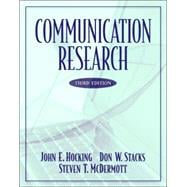
Most chapters begin with “Objectives” and conclude with “Applying Knowledge in Communication,” “Summary,” “Probes,” “Research Projects,” “Suggested Reading,” “Notes,” and “References.”
Preface.
PART I THEORY AND RESEARCH METHODS.
1. Asking and Answering Questions.
Research and Sources of Information.
Research and the Consumption of Information.
Asking Questions About Communication.
Epistemology.
2. The Role of Theory in Communication Research.
Approaches to Studying Communication.
Theoretical Orientations.
Scientific Research and Theory.
Humanistic Research and Theory.
3. Considerations: Knowledge, Ethics, and Science.
Rules of Scholarship.
Treatment of Human Subjects (People).
Debriefing.
Ethical Appropriateness.
A Parting Note.
PART 2 METHODS OF COMMUNICATION RESEARCH.
4. Getting Started: Finding and Evaluating Documents.
Obtaining Documents.
Establishing the Parameters of Study.
The Role of Documents.
Primary versus Secondary Sources.
Finding Sources.
Establishing a Notation System.
Establishing a Document's Credibility.
Putting It All Together: The Literature Review.
Creating the End Product.
5. Evaluating Sources: Historical/Rhetorical-Critical Methodology.
An Overview of Historical Research.
Historical Methodology.
Rhetorical-Critical Methodology.
Limitations and Hazards in Historical Research.
6. Measurement Theory.
What is Measurement?
Reliability.
Validity.
The Relationship Between Reliability and Validity.
7. Measurement Scales.
Attitudes as Examples of Intervening Variables.
Types of Measurement Scales.
Other Measurement Techniques.
8. Content Analysis
Uses of Content Analysis.
Defining the Method.
Conducting the Content Analysis.
Sampling.
Use of Computers in Content Analysis.
Advantages and Limitation of Content Analysis.
9. Qualitative/Descriptive (Participant-Observation/Focus Group/In-Depth Interview).
Methodology.
Participant-Observation.
Focus Groups.
In-Depth Interviews.
10. Quantitative/Sampling.
Sampling Theory.
Nonprobability Sampling.
Probability Sampling.
Sample Selection.
Contacting Respondents.
11. Quantitative/Descriptive (Survey) Research.
Types of Descriptive Research.
The Survey as Descriptive Methodology.
Collecting the Data.
Structuring the Survey.
“Journalistic” Surveys.
Other Considerations.
12. The True Communication Experiment.
Advantages.
Establishing Relationships.
Establishing Causation.
Questions Appropriate for Experiments.
The Laboratory Experiment.
Role-Playing as an Alternative to Deception In Experiments.
Limitations of the Laboratory Experiment.
13. Experimental Strategies and Designs.
Quasi-Experimental Design.
External Validity.
More Complex Designs.
PART 3 MODES OF ANALYSIS.
14. Descriptive Statistics.
Types of Data.
Distributions.
Coding Data for Analysis.
Describing Nonparametric Data.
Bivariate: Correlational Analysis.
15. Applications of Communication Research.
Various Applications of Communication Research.
16. Inferential Statistics.
Using Statistics to Test Hypotheses.
Nonparametric Statistics.
Parametric Analysis.
17. Bringing it Together: Writing and Presenting Research.
Preparing the Final Product.
Writing the Academic Research Report.
Writing the Nonacademic Research Report.
Visual and Oral Presentations.
Special Case: The Research Prospectus/Proposal.
Glossary.
Index.
The New copy of this book will include any supplemental materials advertised. Please check the title of the book to determine if it should include any access cards, study guides, lab manuals, CDs, etc.
The Used, Rental and eBook copies of this book are not guaranteed to include any supplemental materials. Typically, only the book itself is included. This is true even if the title states it includes any access cards, study guides, lab manuals, CDs, etc.